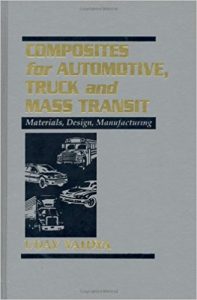This technical book provides a comprehensive explanation of how advanced composite materials, including FRPs, reinforced thermoplastics, carbon-based composites and many others are designed, processed and utilized in exterior, interior, under-the-hood, structural, semi-structural and non-structural components in passenger cars, performance cars, trucks, motorbikes, and mass transit vehicles. The book clarifies how the material properties of composites can be optimized to decrease weight, expand design options, improve crashworthiness, and reduce fuel consumption in response to CAFE and other regulations. The many case studies and equation-based analyses in this book are intended to assist engineers and others in the selection of materials and the fabrication of vehicle parts.
The book covers topics including:
- Technical explanation of composite materials in vehicle design and manufacture
- Covers all phases of composites design, formulation, fabrication, and testing
- Features hundreds of case studies and hard-to-find formulas and analytical data
- Detailed information on resins, preforms, lightweighting, biobased materials
CHAPTER 1: INTRODUCTION
1.1 Introduction
1.2 History and Legislative Actions
1.3 The Case for Lightweighting
1.4 Technological Barriers
1.5 Advantages and Opportunities
1.6 Integral Factors
1.7 Summary
1.8 References
CHAPTER 2: POLYMER RESINS, ADDITIVES AND SANDWICH CORES FOR AUTOMOTIVE, MASS TRANSIT AND HEAVY TRUCKS
2.1 Introduction
2.2 Polymer Resins: Thermoset and Thermoplastic
2.3 Thermoset Polymer Composites
2.4 Thermoplastic Resins
2.5 Additives
2.6 Structural Foams and Core Materials
2.7 Summary
2.8 References
CHAPTER 3: REINFORCEMENTS FOR AUTOMOTIVE AND TRANSPORTATION APPLICATIONS
3.1 Reinforcing Fibers
3.2 Reinforcement Length Scales and Forms
3.3 Glass Fibers
3.4 Carbon or Graphite Fibers
3.5 Aramid (“Kevlar”) Fibers
3.6 High-Strength Polyolefin Fibers
3.7 Basalt Fibers
3.8 Summary
3.9 References
CHAPTER 4: MATERIAL FORMS FOR AUTOMOTIVE, HEAVY TRUCKS AND MASS TRANSIT
4.1 Need for Intermediate Material Forms
4.2 Preforming
4.3 Intermediate Material Form for Thermoplastic Composites
4.4 Summary
4.5 References
CHAPTER 5: DISCONTINUOUS REINFORCEMENT-BASED PROCESSES FOR AUTOMOTIVE AND TRANSPORTATION APPLICATIONS
5.1 Discontinuous Forms
5.2 Glass Mat Thermoplastic Composites (GMT)
5.3 Long Fiber Thermoplastics (LFT)
5.4 Sheet Molding Compound (SMC)
5.5 Compression Molding
5.6 Programmable Powdered Preform Process (P4)
5.7 Structural Foam Molding
5.8 Other Application Case Studies with Discontinuous Fiber Composites
5.9 Exterior
5.10 Interior
5.11 Lightweighting Fuel Cells
5.12 Summary
5.13 References
CHAPTER 6: CONTINUOUS FIBER REINFORCEMENT BASED PROCESSES FOR AUTOMOTIVE, HEAVY TRUCKS AND MASS TRANSIT
6.1 Continuous Fiber Composites
6.2 Preforming
6.3 Continuous Fiber Processes for Automotive and Transportation Applications
6.4 Application Case Studies with Continuous Fiber Reinforcements
6.5 Summary
6.6 References
CHAPTER 7: MECHANICS AND DESIGN TIPS
7.1 Test Methods and Specific Properties
7.2 Conversion Between Volume and Weight Fractions
7.3 Stiffness and Strength Prediction of Discontinuous and Continuous Fiber Composites
7.4 Stiffness Equivalency
7.5 Sandwich Composites
7.6 Ribbed LFT and Tape Reinforced LFT
7.7 Summary
7.8 References
CHAPTER 8: COMPOSITE MANUFACTURING PROCESS ANALYSIS FOR AUTOMOTIVE PARTS
8.1 Background
8.2 Production Requirements
8.3 Representative Part
8.4 Cost Analysis
8.5 Economic Benefit for the Material Supplier
8.6 Summary
8.7 References
CHAPTER 9: CARBON FIBER
9.1 Background
9.2 Challenges
9.3 Typical Properties of Automotive Carbon Fiber Composites
9.4 Carbon Fibers in Cars
9.5 Summary
9.6 References
CHAPTER 10: PERFORMANCE CARS
10.1 Background
10.2 Performance Cars
10.3 Hypercar
10.4 Futuristic Concept Cars
10.5 Race Motorbikes
10.6 Summary
10.7 References
CHAPTER 11: HEAVY TRUCKS AND MASS TRANSIT
11.1 Commercial Motor Vehicles (CMVs)
11.2 Role of Composites in Mass Transit
11.3 Composite Subelements for Mass Transit
11.4 Summary
11.5 References
CHAPTER 12: JOINING AND ADHESIVES
12.1 Joining and Bonding Strategies
12.2 Adhesive Bonding
12.3 Fusion Bonding/Welding
12.4 Joining in Automotive and Transportation Components
12.5 Summary
12.6 References
CHAPTER 13: BIOCOMPOSITES, RECYCLING AND ENVIRONMENTAL ASPECTS
13.1 Need for Environmentally Friendly Materials
13.2 History
13.3 Regulations
13.4 Green Materials/Natural Fibers
13.5 Bio-Resins and Nanoclay Modified Resins
13.6 Nanocomposites
13.7 Intermediate Forms
13.8 Examples of Natural Fiber and Biocomposite Automotive Parts
13.9 Recycled Composite Scrap for Transportation
13.10 Summary
13.11 References
CHAPTER 14: OVERALL SUMMARY
14.1 Overall Trends
14.2 Opportunities and Challenges
